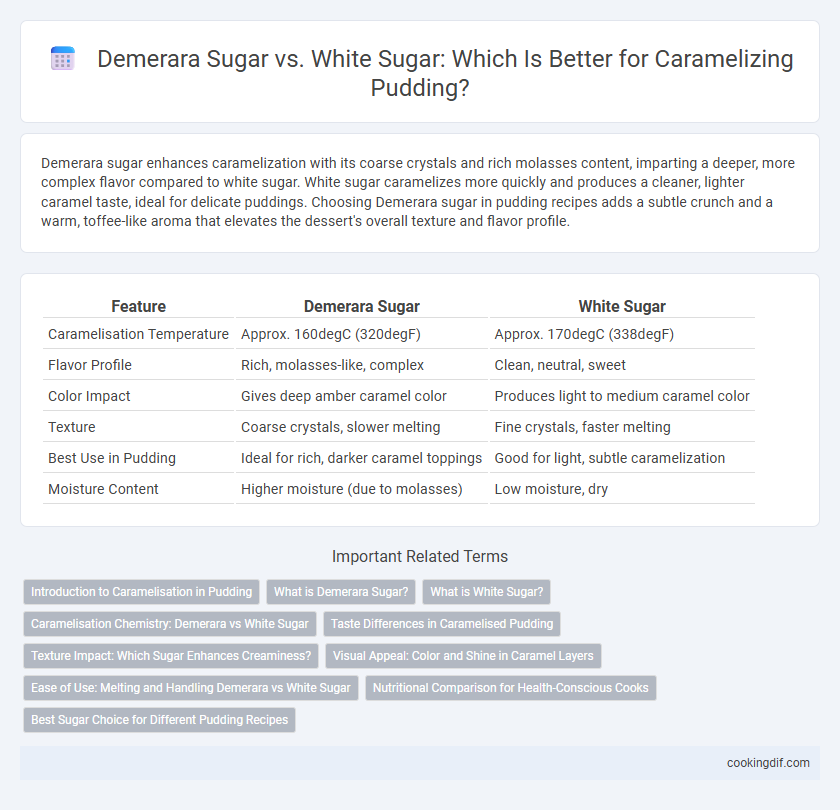Demerara sugar enhances caramelization with its coarse crystals and rich molasses content, imparting a deeper, more complex flavor compared to white sugar. White sugar caramelizes more quickly and produces a cleaner, lighter caramel taste, ideal for delicate puddings. Choosing Demerara sugar in pudding recipes adds a subtle crunch and a warm, toffee-like aroma that elevates the dessert's overall texture and flavor profile.
Table of Comparison
| Feature | Demerara Sugar | White Sugar |
|---|---|---|
| Caramelisation Temperature | Approx. 160degC (320degF) | Approx. 170degC (338degF) |
| Flavor Profile | Rich, molasses-like, complex | Clean, neutral, sweet |
| Color Impact | Gives deep amber caramel color | Produces light to medium caramel color |
| Texture | Coarse crystals, slower melting | Fine crystals, faster melting |
| Best Use in Pudding | Ideal for rich, darker caramel toppings | Good for light, subtle caramelization |
| Moisture Content | Higher moisture (due to molasses) | Low moisture, dry |
Introduction to Caramelisation in Pudding
Demerara sugar enhances pudding caramelisation with its large crystals and natural molasses content, creating a richer, deeper flavor and a more textured caramel layer compared to white sugar. White sugar, composed purely of sucrose, produces a cleaner, more uniform caramel but lacks the complex taste notes found in Demerara. Understanding the differences in caramelisation helps optimize pudding recipes for desired taste and texture outcomes.
What is Demerara Sugar?
Demerara sugar is a minimally refined raw cane sugar with large, amber-colored crystals known for its natural molasses content, which enhances caramelization with a richer, more complex flavor compared to white sugar. Unlike white sugar, which is fully refined and lacks molasses, Demerara supports deeper browning and a subtle caramel taste ideal for puddings and dessert toppings. Its coarse texture also adds a slight crunch, making it a popular choice for surface caramelization.
What is White Sugar?
White sugar, also known as granulated sugar, is a highly refined sweetener derived from sugarcane or sugar beets, consisting almost entirely of sucrose crystals. It has a fine texture and pure white color, making it ideal for consistent caramelization due to its uniform melting point and predictable browning behavior. Unlike Demerara sugar, which retains some molasses, white sugar produces a cleaner, lighter caramel flavor essential for delicate pudding recipes.
Caramelisation Chemistry: Demerara vs White Sugar
Demerara sugar contains larger crystals and higher molasses content, which influence its caramelization chemistry by producing deeper, more complex flavors and a richer amber color compared to white sugar. White sugar, primarily sucrose with minimal impurities, caramelizes at a consistent temperature around 160degC, resulting in a cleaner, more neutral caramel taste. The presence of molasses in Demerara promotes Maillard reactions alongside caramelization, enhancing flavor complexity in pudding recipes.
Taste Differences in Caramelised Pudding
Demerara sugar produces a richer, more complex caramel flavor in pudding due to its higher molasses content, imparting deep caramel notes and a slightly crunchy texture. White sugar creates a cleaner, more neutral caramel taste with a smooth texture, allowing other pudding flavors to dominate. The choice between Demerara and white sugar significantly influences the depth and intensity of caramelization, enhancing the overall taste profile of caramelized pudding.
Texture Impact: Which Sugar Enhances Creaminess?
Demerara sugar, with its larger crystals and higher molasses content, enhances the creaminess of pudding by promoting a smoother, richer texture during caramelization. White sugar caramelizes more quickly but can create a firmer texture that lacks the depth of creaminess found in Demerara sugar. Choosing Demerara sugar results in a velvety pudding with a complex caramel flavor and a luscious mouthfeel.
Visual Appeal: Color and Shine in Caramel Layers
Demerara sugar creates a richer, amber-colored caramel layer with a glossy finish, enhancing the visual appeal of puddings through its natural molasses content. White sugar produces a lighter, more translucent caramel that may lack the depth and shine offered by Demerara sugar. The choice between these sugars directly impacts the caramel's color intensity and reflective quality, influencing the overall presentation.
Ease of Use: Melting and Handling Demerara vs White Sugar
Demerara sugar caramelizes more slowly due to its larger crystals and natural molasses content, requiring higher heat and careful monitoring to prevent burning. White sugar melts quickly and evenly, making it easier to handle and ideal for smooth, consistent caramel in pudding recipes. White sugar's fine texture ensures faster caramelization, while Demerara demands patience but adds a richer, more complex flavor.
Nutritional Comparison for Health-Conscious Cooks
Demerara sugar contains trace minerals like calcium, iron, and potassium absent in white sugar, offering marginally higher nutritional value for health-conscious cooks. Its larger crystals and natural molasses content influence caramelization by producing a richer flavor and deeper color compared to the cleaner, more refined white sugar. Despite these differences, both sugars are similar in calorie content, so portion control remains key for maintaining a balanced diet when caramelizing pudding.
Best Sugar Choice for Different Pudding Recipes
Demerara sugar, with its large crystals and rich molasses content, caramelizes more slowly and imparts a deep, toffee-like flavor ideal for sticky puddings like treacle or sticky toffee pudding. White sugar caramelizes quickly, producing a clear, golden caramel perfect for smooth custard-based desserts such as creme caramel or flan where a delicate caramel layer is desired. Choosing between Demerara and white sugar depends on the pudding texture and flavor intensity, with Demerara best for robust, textured caramel and white sugar preferred for light, evenly caramelized toppings.
Demerara sugar vs white sugar for caramelisation Infographic

 cookingdif.com
cookingdif.com